Prepared as part of Sheffield Black History Month, 7th October 2016, Sheffield Hallam University..
I need to begin with Evelyn from the Internets clip on Lemonade because it summarises why I and so many Black women fell in love with Beyoncé’s visual album. I find it incredibly difficult to write this presentation since I can and have spent hours talking to anyone who would listen (sometimes involuntarily) about everything that I love about Lemonade, so it’s going to be hard being concise.
I’m going to begin with the importance of Lemonade as a Black feminist artefact for those of us in the Black diaspora across the West. Then I’ll spend some time with just some of the visuals in Lemonade. I’m hoping that from there we can have a general conversation about Lemonade and Beyoncé’s performances around this album as it relates to Black feminism.
My emotional response to Formation and then Lemonade came from an overwhelming relief at the centring and diversity of Black female bodies in a way that I have never, ever seen before. When trying to watch other tv shows and films after Lemonade I realised that part of the insidious effects of white supremacy is the centring of white bodies as the norm when telling any stories.
Even within the Shondaland Empire which has made truly amazing progress in centring Black women, Shonda Rhimes had to start off with shows that centred white women with Grey’s Anatomy and Private Practice. In Scandal and How to Get Away With Murder, the complex Black female protagonists still had to be surrounded by white bodies (although it is noteworthy to see how that’s changed as Shonda Rhimes has become more and more famous).
Other than that, an overwhelming number of films & tv shows where Black women have leading parts in the West are around slavery, civil rights or ghetto-life. Through these mediums we are forced to watch Black bodies being brutalised for the titillation of majority white audiences. It is telling that someone as talented and beautiful as Lupita Nyongo’o would only be recognised and employed in a big budget film as a Black female when she is portraying a beaten and raped slave.
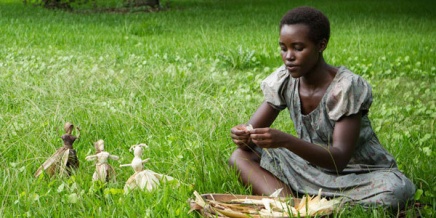
When these are the only roles that are available to Black women, it is clear that it is not the diversity of our experiences that are being told through the screen. It is not our narrative but a reflection of how white supremacy tells the tale of Black inferiority. Our bodies are consumable through stereotypes and easily rendered as worth-less.
I’ve got to admit that I wasn’t really a Beyoncé fan until Formation dropped. For a long time, Beyoncé was positioned by white women as a sanitised, de-racialised artist that they could relate to whilst still using her Blackness to engage with caricatures of the ‘sassy’ ‘crazy in love’ hypersexual ‘diva’.
This was a role that I have no doubt Beyoncé created for herself: for a long time she has been an integral part of controlling the image of Beyoncé that is put out for mass-consumption.
But I knew the alter-ego of Sasha Fierce did not speak to my experiences as a racialized and gendered person. This was a strong Black woman who could maintain strength without showing any sign of exhaustion (cos she “woke up like this”).

This was a sassy Black women whose anger and ‘sass’ was disconnected from seeing Black people routinely killed because she was “flaw-less”. This was a character created explicitly and carefully for the white gaze.

It wasn’t until Formation dropped that I realised how much my focus on this character prevented me from seeing her as a person who was trying to manoeuvre and gain success within a mainstream industry that caters almost exclusively to the white gaze. Time and time again, the mainstream music industry has proven to be a space within which Black bodies are objectified and consumed: from the Black female diva to the uber-masculine Black ‘thug’ rapper, the lesson we have been taught is that Black bodies must be objectified in order to be successful.
Mainstream media is not exceptional in this regard: at different points in time I have found myself working to control my body and temperament so that it is acceptable to those around. Don’t appear too angry or they’ll get scared and see you as an irrational Black woman. Don’t appear too Muslim or they’ll get scared and call you a terrorist. Smile through the racist remarks or they’ll call you bitter. Keep calm when explaining your humanity for the billionth time to people who play “devil’s advocate” so easily. Try not to bring attention to your body as out of place within a Western world that would like to remake itself as white.
Since I know I do this, it should not come as a surprise that other Black women have also become good at these manoeuvres. I dehumanise Beyoncé when forgetting the characters that we all play to exist (and succeed) within a Western world that has defined these social categories. This is a charge that I (and many others) accuse bell hooks of doing when she dismisses Lemonade and Beyoncé in her review.
It’s also important to remember that the particular brand of Black capitalism that Beyoncé adheres to (where “the best revenge is your paper”) includes participating and playing with these stereotypes which have been defined within Western society and focusing on making money as a way to move Black people forward. Whether you agree with the logic of Black capitalism or not (and personally, I don’t), it is obvious that she has done this effectively.
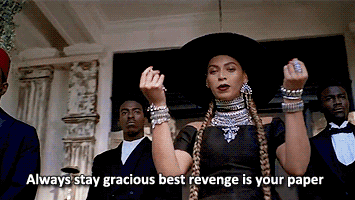
But Lemonade is so much more than Beyoncé excelling at capitalism – it shows these caricatures of Black womanhood being challenged by Black women that survive under these systems of white supremacy. As Ngaio Anyia has stated, “this is not Sasha Fierce, not an alter-ego but a black woman who has struggled with a common cultural issue – that it is our very substance that allows us to be disregarded or judged.” This visual album was Beyoncé forcing consumers to interact and see her Blackness as she puts it forward. This is not a Black body that is presented for a white gaze.
When you watch this film, you must first and foremost see and hear Beyoncé and Warsan Shire as cultural producers. You must engage with a multiplicity of Black bodies, all of whom are stylised in a variety of fashions.
You must see Beyoncé unashamed in working through heartbreak, confusion, anger, sexuality, resilience and love for other Black women. You must see the bitter pills that life can hand us and our attempt to ‘find beauty where there was none.’

It is telling that the initial reviews of Lemonade didn’t actually know what to do with it as a product. Mainstream film and music critics (who are overwhelmingly white) could speak of the excellent cinematography or speculate about the alleged affair, but they didn’t have the language to understand why this piece resonated with so many Black women. This led to media outlets like the BBC, the Guardian and The Independent having to find Black female writers who could express why this piece was so important.
I remember laughing when I saw that Piers Morgan had written an article and (oh so typically) relied on this narrative of Beyoncé as the angry Black woman to talk about his dislike of Lemonade.
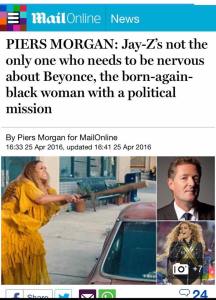
Here he was attempting to centre his own opinion of what Blackness should mean because Lemonade was a story that was in no way developed with his gaze or body in mind. To this day, I have not read his article because his reaction was so laughably irrelevant to the many different parts of what Lemonade was trying to achieve. I would much rather work through what is being done within Lemonade than re-centre a language of white supremacy (where Black anger is seen as threatening).
There are plenty of criticisms that have been made of Lemonade by Black feminists (beginning with the absence of any fat or differently abled bodies from the film) and these are necessary to unpack over and beyond the opinion of any white person. By centring her experiences of Blackness, Beyoncé opens up the possibility of us doing the same and centring our own experiences of Blackness. It’s not about how others view us, but how we view and learn about ourselves.
Part of the beauty of Lemonade is that there is no singular image of Black womanhood that is presented. This naturally lends itself to the sharing of knowledge amongst Black women, something that Black feminism has always understood as an instrumental part of our development. Many of the reflections that I make in this talk have come from the many conversations I was lucky to have with Women of Colour who had seen and reflected on different parts of Lemonade.
As these university institutions have historically been inaccessible to Women of Colour, Black feminists have looked to music, film, literature, hair salons, kitchens and everyday conversations as spaces where we learned more about ourselves and the systems which we are attempting to navigate. Lemonade has encouraged more of these conversations, and shown us how to begin this process from a place of love and respect of our differences.
There are two images I use to illustrate this: the yellow dress Beyoncé wore in Hold Up and the dress that we first saw in Daddy Lessons.
I felt so much joy when I first saw Beyoncé rock this West African print dress, stylized to remind us of Southern antebellum clothing. This was especially important in a song where she begins by reminding us of her roots in Texas and country music. As she repeats the word Texas at the beginning of the song, the images of Black people show us a Texas we are not used to seeing – it is not the image of the white cowboy, but a Texas that is filled with many different experiences and expressions of Blackness. This shows our Blackness and Western identities working together and creating something beautiful rather than being seen as “clashing” with one another.
Although some people seemed to credit Beyoncé’s team for the way the material was stylised, the taking of this print material and changing it into modern fashion is incredibly common across West Africa and for those of us in the diaspora who came from West African countries. Beyoncé wears this dress with pride whilst singing about a developing sense of self-respect: this multi-coloured material that we are conditioned to see as out of place for Western audiences becomes known as a part of high fashion and beauty.
Although I could appreciate what was done here, I wasn’t able to understand the significance behind the yellow dress that was worn in Hold Up and the casual violence exhibited throughout the song. I learned about this particular style through the words of Maximiliano Goiz, a practitioner of Santeria which is an offshoot from Yoruba based religions that travelled to Black diaspora communities in Latin America and the Caribbean. Her dress is styled after the deity Oshun who was known as a figure of love, healing, and sensuality. But this deity had also suffered abuse, neglect and loss.
When she went about exacting revenge against those that had wronged her, her methods were known as unpredictable, and her wrath was paired with joy, dancing and laughter. This was the tradition that Beyoncé’s team were looking back upon through the song.
This shows us different contexts of Black womanhood that are weaved together in this piece. It responds to Audre Lorde’s (1996:163) charge that we need to stop pretending our differences are insurmountable and instead use our differences as ‘a springboard for creative change.’
As Maryam Jameela told me, in the role reversal that has Beyoncé lounging across a throne (reminiscent of Serena Williams’ Sports Illustrated cover image) whilst Serena Williams dances in heels (reminiscent of Beyoncé’s role as a performer) we see two Black female celebrities showing a respect for the roles which they each play and having fun with it. Lemonade encourages us to look back at our differences and work towards (as Lorde points out) ‘new patterns of relating across these differences.’
Lemonade encourages us to begin this task by challenging the way Black bodies have historically been objectified.For this, we have scenes like the one at the end of 6 inch where Black women are stood in front of a house that is burning.
Immediately, the alternative visual that comes to mind is that of the KKK and burning crosses and houses that have been used to terrorize Black bodies. Here that image is reversed: we do not see images of Black death and suffering, images where our eyes are downcast or closed, images that have perpetuated a de-sensitization towards Black bodies being brutalised.
Here we have immaculately dressed Black women in several different hairstyles, staring directly at the screen, still standing even whilst a house burns down behind them. They survive, and they force you to see and respond to their survival.
There was a similar visual that stuck out for me at the end of Freedom when we saw Black women (including Zendaya, Amandla Stenberg and Beyoncé) sitting on this grand old tree with waves of Black women stood in front of them.
Rather than seeing Black bodies lynched from these huge branches, these women are still standing (or sitting on top of) and looking beyond these histories. We (as a collective) stand as more than this history of lynching and enslavement and fight for a freedom whilst understanding our past.
This is similar to a manoeuvre done by Beyoncé and Kendrick Lamar when performing Freedom at the BET Awards. At the end of this performance, you see Beyoncé and Kendrick Lamar dancing and kicking water at each other, playing in water whilst demanding that our freedom cannot wait.
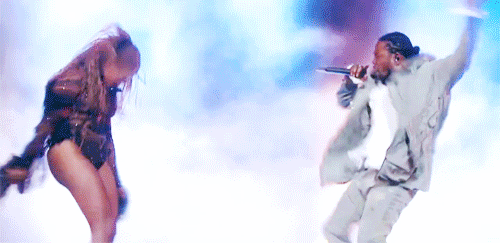
There are a number of important experiences with water that are relevant in this visual: first, there is the history of the trans-Atlantic slave trade and the many Black people who died or committed suicide and will forever be at the bottom of the Atlantic Ocean.
Within the African-American context, there is also a history of segregation which meant that swimming pools were not accessible to Black people. As of last year, a video went viral of a police offer in Texas pulling his gun on a group of teenagers and tackling a 15 year old Black girl wearing a bikini after someone reported on their neighbourhood pool party.
Having two Black superstars playing and kicking in water is especially important because of how Black bodies in water have been connected to various forms of oppression. Rather than understanding the water as solely connected to violence, loss and grief, Kendrick Lamar and Beyoncé move forward with this history and demand our freedom to show anger, to show joy and to just be. And that is just glorious.
But sometimes it is hard to see beauty beyond the violence of the state. The first time I saw Formation, I remember feeling stricken with fear at the scenes of the young Black boy dancing in a black hoodie in front of white cops in riot gear.
It immediately connected to the knowledge that Tamir Rice had been killed for playing with a toy gun, and the fear that Black children’s joy would be seen as threatening. And yet seeing this child dance defiantly in the face of this symbol of state violence speaks to the possibilities of resistance within our Blackness in the face of white supremacy. There is something so hopeful and beautiful in our ability to have joy despite the violence that we are facing.
It’s interesting to think of this alongside the anger that Beyoncé shows in Don’t Hurt Yourself which made me take a step back because I wasn’t used to seeing it.
I had become so accustomed to Black anger being sanitized and controlled for fear of being cast in the oh so well known character of the angry Black woman. Because of this, seeing a Black woman, in braids, looking directly at the screen and screaming at you that “Tonight I’m fuckin’ up ALL YOUR SHIT BOY” was a thing of beauty.She releases this anger and allows us as Black women to see it, feel it, and give voice to it as well.
I remember seeing a clip of Zendaya (one of the young artists featured in Lemonade) dressed in cornrolls lip-synching to the lines: “you can watch my fat ass twist boy, as I bounce to the next dick boy.”
For me, this was monumental, and speaks to my hopes for Lemonade as a cultural artefact more generally: young Black girls can form a connection with Beyoncé’s words and embrace an anger and a self-confidence that we are told to filter down. They can embrace a sense of self-worth that comes from understanding the heartbreak that is a part of life, but the need to push forward beyond this. Our worth cannot be defined in relation to those that devalue our love and bodies, and Lemonade pushes Black women across the Western diaspora to understand this.
Ironically, this was the main message that I got from the hotly debated line “Becky with the Good Hair” where “Becky” was a code name for a generic white woman. Black feminists like bell hooks (1981) and Shirley Tate (2015) have explained the way in which Black femininity is defined as excessive and deviant from white femininity.
This is the logic of white supremacy that Kanye West speaks from in Gold Digger when joking about a Black woman who supports her man until he “leaves your ass for a white girl.” Our hair practices are forever seen as weird and bad in comparison to white women’s natural “good” hair. Our bodily features are seen as secondary to that of white bodies (even or especially when features that are normally used to fetishize Black bodies are then admired on white bodies).

With this line though, Beyoncé reverses the role of the Black woman as secondary to white beauty. Beyoncé is resolute that her and her baby will be fine, so her partner can go find this woman that’s meant to be the standard of beauty (with “good hair”) because he is not right for her.

Rather than accepting a position as secondary or deviant, her own emotional needs are centered. This is rounded up with a meticulously choreographed neck-roll that is often associated with Black women’s “sass.” All of it is brought together to show beauty in our positioning as Black bodies, and to denounce a standard of beauty that has shamed our bodies for so long.
I’m going to end by beginning a discussion about our favourite scenes/songs from Lemonade. My own personal favourite was Daddy Lessons (in part because I like to think of a lot of country fans losing their shit over a Black woman singing an excellent country song).
In this song, the “Daddy” warns Beyoncé that when men like him come to town she should shoot them. This song in particular makes me think about the difficult relationship that Black feminists have had with Black men wherein, to paraphrase the Combahee River Collective (1978), we love and fight with them against white supremacy, but we also fight against Black men in relation to patriarchy.
I don’t think Daddy Lessons is only meant to be about an actual father figure, but about these historically “Great Black Men” (e.g. Martin Luther King Jr., Malcolm X, Huey P. Newton, etc.) who were great, but who were also deeply invested in Black masculinity focusing on fighting through statements like “if you’re a real man, you take your freedom”.
There’s a point in the song where the Daddy figure has died and instead Beyoncé is referring to an internalised father figure. At this point it becomes her own subconscious speaking that warns her that she is being played. These internalised lessons of self-respect are intertwined with the misogyny that goes along with this brand of Black masculinity: after all, the ‘Daddy’ is warning her away from a masculinity that he also performs.
So we need to find a way to uncouple the misogyny from the lessons of self-respect that we can gain from these “Great Black Men” – this comes from valuing a sense of community amongst Black women, and finding strength through that (something which is developed further in Love Drought).
I could easily go on, but I think I’m going to stop there for now and ask you to speak to your own experiences of watching and engaging with Lemonade since for me, that has been some of the best bits of watching and re-watching Lemonade. As well as the gif with Chance the Rapper and Beyoncé.
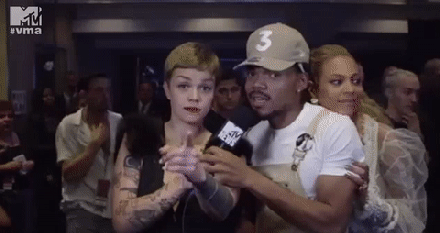
References
- Combahee River Collective (1978)’A Black Feminist Statement.’ in: Zillah Eisenstein (ed.) Capitalist Patriarchy and the Case for Socialist Feminism. New York: Monthly Review Press, 210-218.
- hooks, b. (1981). Ain’t I a woman : Black women and feminism. Boston, MA, South End Press.
- Lorde, A. (1996)[1980]. ‘Age, Race, Class, and Sex: Women Redefining Difference.’ The Audre Lorde Compendium: Essays, Speeches and Journals. London: Pandora, 162-171.
- Tate, S. A. (2015). Black Women’s Bodies and The Nation: Race, Gender and Culture. Basingstoke, Palgrave Macmillan.


























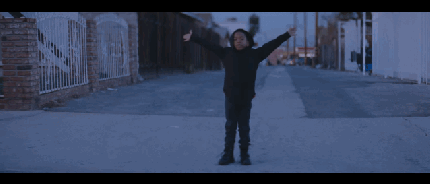








great piece. hope the event was good.
the issue about good hair is summed up so perfectly here, i think. people were going wild about who becky was, or how somebody could cheat on beyonce. as u allude to here, i think, infidelity often triggers people to ask Q’s about what they r missing that caused a partner to stray. when that absence of a quality is racialised like that, it’s especially profound.
anyway, great piece pal. awesome gifs too obvs
ros
LikeLiked by 1 person